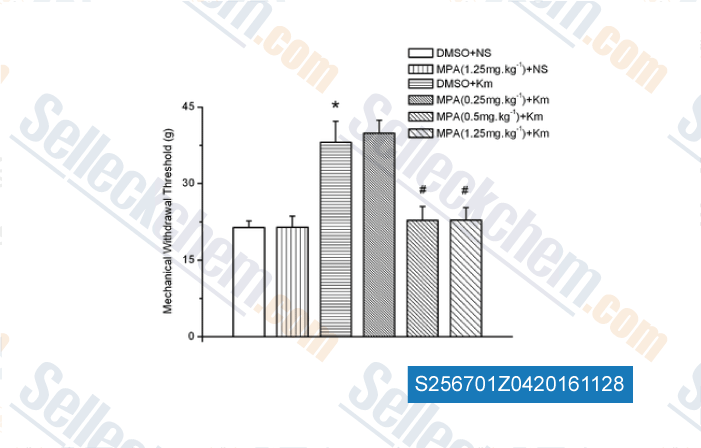|
Toll Free: (877) 796-6397 -- USA and Canada only -- |
Fax: +1-832-582-8590 Orders: +1-832-582-8158 |
Tech Support: +1-832-582-8158 Ext:3 Please provide your Order Number in the email. |
Technical Data
| Formula | C24H34O4 |
||||||
| Molecular Weight | 386.52 | CAS No. | 71-58-9 | ||||
| Solubility (25°C)* | In vitro | DMSO | 18 mg/mL (46.56 mM) | ||||
| Ethanol | 15 mg/mL (38.8 mM) | ||||||
| Water | Insoluble | ||||||
| In vivo (Add solvents to the product individually and in order) |
|
||||||
|
* <1 mg/ml means slightly soluble or insoluble. * Please note that Selleck tests the solubility of all compounds in-house, and the actual solubility may differ slightly from published values. This is normal and is due to slight batch-to-batch variations. * Room temperature shipping (Stability testing shows this product can be shipped without any cooling measures.) |
|||||||
Preparing Stock Solutions
Biological Activity
| Description | MPA (Medroxyprogesterone acetate) is a synthetic progestin and act as a potent progesterone receptor agonist, used to treat abnormal menstruation or irregular vaginal bleeding. | |
|---|---|---|
| Targets |
|
|
| In vitro | Medroxyprogesterone acetate (MPA) inhibits the enzyme 3-hydroxyste-roid dehydrogenase, involved in the reversible conversion between 5alpha-dihydroprogesterone (DHP) and 3alpha, 5alpha-tetrahydroprogesterone (THP), and therefore may affect the local actions of DHP and THP in the brain. [1] Medroxyprogesterone acetate (MPA) reduces secretion of IL-6 and PTHrP from human breast cancer cells. MPA dose-dependently decreases the secretion and mRNA expression of IL-6 and PTHrP in the KTC-2 cells. [2] Medroxyprogesterone acetate (MPA) and dexamethasone dose dependently increases alpha-ENaC promoter-driven luciferase activity in M-1 cells, which is not inhibited by Org31710, indicating that Medroxyprogesterone acetate regulates alpha-ENaC in a PR-independent manner. Medroxyprogesterone acetate and dexamethasone, but not progesterone, dose dependently increases alpha-ENaC and sgk1 mRNA in M-1 and in Madin-Darby canine kidney-C7 cells, both collecting duct cell lines. [3] Medroxyprogesterone acetate (MPA) (0.1 nM) significantly enhances the in vitro production of specific immunoglobulin G (IgG) antibodies, an effect that appears to involve the interaction of the progestin with PRG receptors[4] |
|
| In vivo | Medroxyprogesterone acetate (MPA) impairs delayed memory retention on the water radial-arm maze (WRAM), and exacerbates overnight forgetting on the Morris maze (MM) in aged ovariectomized (OVX) rats. Medroxyprogesterone acetate (MPA) significantly and progesterone marginally decreases GAD levels in the hippocampus, and both MPA and progesterone significantly increases GAD levels in the entorhinal cortex. [5] |
Protocol (from reference)
| Cell Assay: |
|
|---|---|
| Animal Study: |
|
References
Customer Product Validation

-
Data from [Data independently produced by , , Molecular Pain, 2015, 11:46.]
Selleck's MPA (Medroxyprogesterone acetate) has been cited by 17 publications
| Investigating Aging-Related Endometrial Dysfunction Using Endometrial Organoids [ Cell Prolif, 2024, e13780.] | PubMed: 39695355 |
| Deficiency of UCHL1 results in insufficient decidualization accompanied by impaired dNK modulation and eventually miscarriage [ J Transl Med, 2024, 22(1):478] | PubMed: 38769534 |
| Inhibition of the transmembrane transporter ABCB1 overcomes resistance to doxorubicin in patient-derived organoid models of HCC [ Hepatol Commun, 2024, 8(5)e0437] | PubMed: 38696353 |
| The role of non-genomic actions of progesterone and its membrane receptor agonist in ovarian cancer cell death [ Cancer Rep (Hoboken), 2024, 7(1):e1934] | PubMed: 38013666 |
| Genome-wide CRISPR screening reveals ADCK3 as a key regulator in sensitizing endometrial carcinoma cells to MPA therapy [ Br J Cancer, 2023, 129(4):601-611] | PubMed: 37402867 |
| Genome-wide CRISPR screening reveals ADCK3 as a key regulator in sensitizing endometrial carcinoma cells to MPA therapy [ Br J Cancer, 2023, 129(4):601-611] | PubMed: 37402867 |
| Elevated high-mannose N-glycans hamper endometrial decidualization [ iScience, 2023, 10.1016/j.isci.2023.108170] | PubMed: 37915610 |
| RNA-seq and ATAC-seq analysis of CD163+ macrophage-induced progestin-insensitive endometrial cancer cells [ Cancer Med, 2023, 12(5):5964-5978] | PubMed: 36373483 |
| RNA-seq and ATAC-seq analysis of CD163+ macrophage-induced progestin-insensitive endometrial cancer cells [ Cancer Med, 2023, 12(5):5964-5978] | PubMed: 36373483 |
| Long-Acting Technologies for Prevention of HIV and Unplanned Pregnancy [ ProQuest, 2023, 30314559] | PubMed: none |
RETURN POLICY
Selleck Chemical’s Unconditional Return Policy ensures a smooth online shopping experience for our customers. If you are in any way unsatisfied with your purchase, you may return any item(s) within 7 days of receiving it. In the event of product quality issues, either protocol related or product related problems, you may return any item(s) within 365 days from the original purchase date. Please follow the instructions below when returning products.
SHIPPING AND STORAGE
Selleck products are transported at room temperature. If you receive the product at room temperature, please rest assured, the Selleck Quality Inspection Department has conducted experiments to verify that the normal temperature placement of one month will not affect the biological activity of powder products. After collecting, please store the product according to the requirements described in the datasheet. Most Selleck products are stable under the recommended conditions.
NOT FOR HUMAN, VETERINARY DIAGNOSTIC OR THERAPEUTIC USE.
